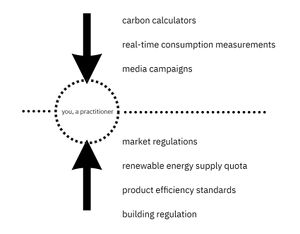
The gig economy is growing alongside the share of workers in tech. For example, it now makes up 4% of the workforce in the United States[1] and is growing worldwide. However, the platforms that control this workforce remain almost exclusively in developed countries, which puts workers in a position where they can be exploited.[2][3] Climate change is one of the ways on which the Internet is creating a direct and physical impact in developing countries, but making that connection requires thinking about how technology, resource extraction and energy demands are related to a webpage or a piece of code.
Who is this guide for?[edit | edit source]
This resource is intended for persons living in areas vulnerable to climate change, that contribute professionally to ICTs and the Internet (what we like to call an Internet practitioner). The concept of Internet practitioner can sometimes be a bit blurry, but consider yourself one if your work, technical or non-technical, helps the Internet operate. Your work could be any (but not limited to) some of these activities:
- Developing technologies over the web
- Focused on business models that make use of the Internet, including social media
- Being part of an IT department for a large company that uses digital technologies internally.
- Software design, development or management
- Telecommunications infrastructure developer and maintainer
- Hardware development for the Internet of Things.
- Working on legal issues for an organization's operation over the web
- Policing and regulation of Internet operation (from a governmental agency, not-for-profit organization, etc.)
- Content creation
- Knowledge management expert (archivist, librarian, content curator, etc.)
- FinTech practitioner
- Contributor to the open movement
- Online educator
Enabling impact from your computer[edit | edit source]
Reducing the carbon footprint of our professional activity as Internet practitioners is not an easy task. For starters, it's difficult to be aware of the effects how we create a carbon footprint when data centers are in other parts of the world. It is also likely that many of the important decisions that drive these changes are not within the influence of developers, web designers and other tech practitioners, but rather of higher roles in charge of strategic decisions such as business models.
However, Internet practitioners are in a privileged position to influence some of these decisions through their work, as much as chefs may impact how nutritious the food served at a restaurant is. Some of these decisions are personal, some are organizational, and others are systemic. In this guide, we will outline some of the elements around these levels of influence so you can evaluate your practice and your organization to help you think of some first steps to be a positive influence through your work to reduce your carbon footprint.
How to use this material[edit | edit source]
This guide is meant to be self-paced. You can do the following:
- Get the handout with the survey questions located here (or get the print version directly).
- Go through the materials which explain each of the items to address on the survey.
- Fill out the survey at the end, which for now is an abridged version of the complete questionnaire. This is optional and anonymous.
Structure of the course[edit | edit source]
- First, assess some initial thoughts on the subject with a short quiz. This is a short, self-assessed resource to start thinking about some of these ideas.
- You can assess the environmental impact of your work on different levels:
- Your personal footprint: the first step towards sustainability is to think about your professional practice.
- Your organization's impact: let's talk about the business model and operations. Which of these do you take part in?
- Local impact. Do you know of any organizations that impact your country or community directly? We will guide you on a short research spree that can help you raise awareness on the subject.
- Survey map: As a final step, we invite you to share some of your assessment results through an anonymous survey and map.
References[edit | edit source]
- ↑ Barua, A. (n.d.). The tech workforce is expanding—And changing—As different sectors battle for talent. Deloitte Insights. Retrieved May 16, 2022, from https://www2.deloitte.com/us/en/insights/economy/spotlight/tech-workforce-expanding.html
- ↑ Iyer, N. (2021, August 31). Remote work risks exploiting workers in low-income countries. Quartz Africa. https://qz.com/africa/2053741/remote-work-risks-exploiting-workers-in-low-income-countries/
- ↑ Berg, J., Hilal, A., El, S., Horne, R., & others. (2021). World employment and social outlook: Trends 2021. International Labour Organization.